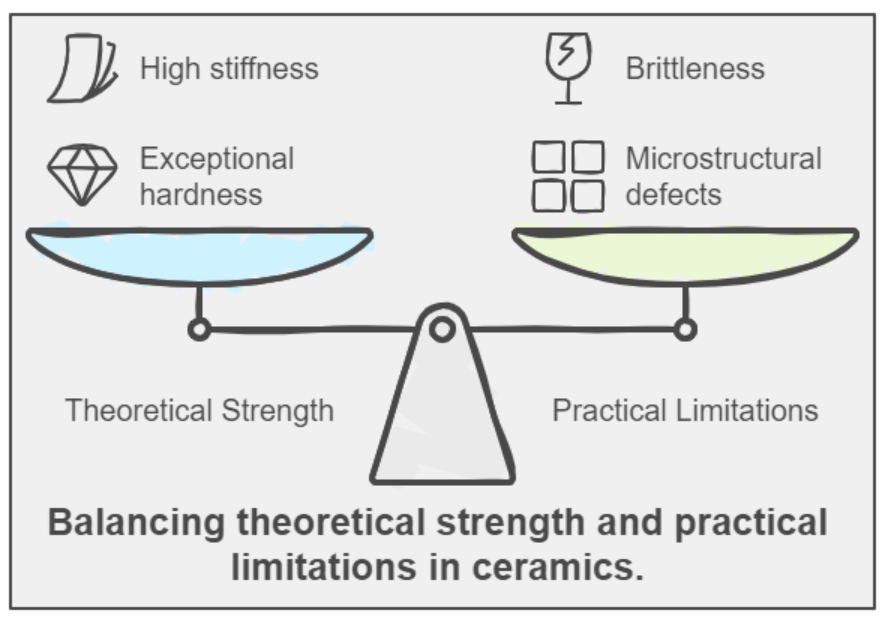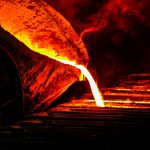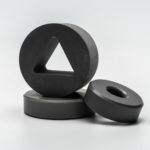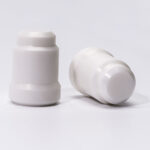High-strength ceramics serve some of the most demanding applications on—and off—earth. These advanced materials, like sialons, are among the strongest mankind has ever engineered and are theoretically capable of withstanding tremendous forces. Why, then, does reality often fall short? Even when performing above user expectations, some ceramics fail to live up to their own promise. This doesn’t generally represent a technical concern, given that engineering ceramics’ real-world performance often eclipses that of traditional materials by orders of magnitude. Yet it could serve as a barrier to future innovation and truly astronomical efficiency gains. Let’s explore why ceramics may fall short of their theoretical strength and what’s being done to bridge the gap.
Theoretical Strength vs. Practical Limitations in High-Strength Ceramics
Ceramics exhibit theoretical strength due to their atomic bonding structure, dominated by ionic and covalent bonds. These bonds create a highly ordered lattice, which maximises resistance to atomic displacement, leading to exceptional hardness and stiffness. The lack of free electrons also contributes to their strength by preventing ductile deformation. However, ceramics are inherently brittle, and any microstructural defects, such as cracks or pores, concentrate stress, significantly reducing their practical strength in real-world applications.
- Microstructural defects: Tiny imperfections in ceramics—pores, grain misalignments, and microscopic cracks—act as stress concentrators that undermine their strength. Unlike metals, ceramics lack plasticity, making them more susceptible to fractures caused by these defects.
- Brittleness and lack of plasticity: Ceramics don’t deform plastically under stress; they break. This brittleness limits their fatigue resistance, and the smallest flaw can trigger a complete failure, making some ceramics challenging to use in dynamic environments.

Challenges in Achieving Theoretical Strength in Practice
High-strength ceramics, while extraordinary, are challenging to produce at their full potential. The quality of raw materials and processing techniques like sintering and hot pressing can make or break their effectiveness.
Processing Limitations
The strength of ceramics depends significantly on processing techniques. While methods like hot pressing can minimize defects, the process is complex and costly. Even with advanced methods, it remains a challenge to produce flawless ceramics on a large scale. State-of-the-art sintering and densification processes are employed to eliminate porosity and optimise the microstructure, significantly enhancing ceramic strength.
Environmental Sensitivity
Ceramics are particularly sensitive to their environment. Exposure to temperature changes, humidity, and chemicals can degrade their properties over time, adding another layer of difficulty to maintaining strength. Careful material selection and the use of stabilising additives like magnesia and yttria help maintain ceramic performance and longevity even in harsh environments.
Tensile vs. Compressive Strength
Ceramics can withstand substantial compressive forces but may be weak under tension. This disparity is critical for applications where tensile strength is required, as ceramics might not perform optimally under these conditions. Tailored material selection helps optimise properties for both tensile and compressive needs, ensuring suitability for specific applications.
Manufacturing Process of Ceramic Products: A Guide for Materials Engineers
Strategies for Bridging the Gap
Despite the practical challenges, ongoing research aims to bring ceramics closer to their theoretical potential through innovative approaches.
- Ductile ceramics: Efforts are underway to create ductile ceramics that can withstand stress without immediate fracture. For example, research on nanoscale silicon nitride (Si₃N₄) shows promise for room-temperature plasticity, which could enhance fatigue resistance.
- Ceramic matrix composites (CMCs): One approach involves reinforcing ceramics with fibers to create ceramic matrix composites. These materials offer improved tensile strength, making them better suited for demanding applications. By distributing stress more evenly, CMCs can enhance durability and bring ceramics closer to their theoretical strength.
- Microstructure optimization: Optimising the microstructure of ceramics can reduce the impact of defects. Techniques like refining grain size and improving grain boundary adhesion have shown promise in increasing ceramic strength, thus enhancing their real-world performance. Advanced microstructure optimisation techniques, such as combining zirconia with alumina matrices reinforced by self-grown alumina platelets, result in ceramics with improved fracture toughness and thermal shock resistance.
Partner with International Syalons for Advanced Ceramic Solutions
At International Syalons, we pride ourselves on our expertise in producing high-strength ceramics that meet the most demanding industrial challenges. With cutting-edge manufacturing processes, tailored material selection, and ongoing research, we ensure our customers receive the highest quality solutions for their unique applications.
Want to learn more? Read our article on Why Advanced Ceramics Excel in High-Temperature Environments
Reach out to our team today to discover how our advanced ceramic materials can enhance the strength and performance of your products.



